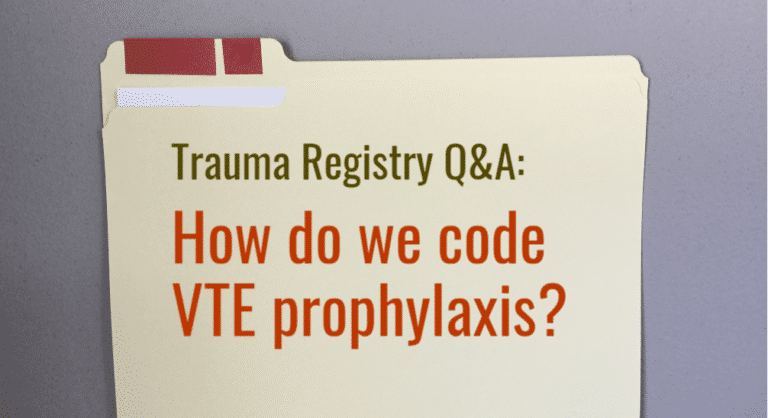The 2019 update of the National Trauma Data Standard (NTDS) Data Dictionary includes several changes to venous thromboembolism (VTE) prophylaxis type. In this month’s column, trauma registry experts from Pomphrey Consulting explain the changes, what they mean and what registrars need to do.
Q. What has changed in 2019 for coding VTE prophylaxis?
The big change has to do with coding heparin use. The 2019 NTDS Data Dictionary has retired the Heparin field value for VTE prophylaxis type. At the same time, the dictionary has introduced Unfractionated Heparin (UH) as a new field value for this data element.
Q. Why was this change made?
The NTDS Data Dictionary introduced the LMWH (low molecular weight heparin) value for VTE prophylaxis several years ago. However, having separate field values for heparin and LMWH caused confusion for many trauma registrars, because LMWH is really a kind of heparin. By replacing Heparin with Unfractionated Heparin (UH), the coding choices for various kinds of heparin are now more logical.
Q. What is the difference between unfractionated heparin and low molecular weight heparin?
UH is how heparin naturally occurs in our bodies. It is made up of polysaccharide chains with weights ranging from 5,000 Da to more than 40,000 Da. UH is generally given by IV and it has a short duration.
LMWH is a group of heparins with low molecular weights. At least 60% of the heparin molecules in LMWH weigh less than 8,000 Da. LMWH has a high anticoagulant effect, so it is generally given in a lower dose than UH. LMWH is given subcutaneously and it has a long duration.
Q. How can registrars know which heparin to code?
You need to find out what specific heparin drugs are being used in your hospital. We recommend talking to your program’s trauma medical director, trauma program manager or pharmacy contact to find out which UH and LMWH drugs are given to trauma patients. If you learn both the generic names and the brand names, it will be easier to identify these drugs in the documentation and code them accurately.
Q. Did coding change for Coumadin?
Yes. The 2019 NTDS Data Dictionary has retired the Coumadin field value for VTE prophylaxis type. In addition, the dictionary has added a clarification that Other should be reported if Coumadin and/or aspirin are given as VTE prophylaxis. So going forward, Coumadin administered as a protective measure against VTE should be coded as Other.
Q. Does use of a sequential compression device count as VTE prophylaxis?
No. The NTDS has added the following additional information to the 2019 Data Dictionary: “Exclude sequential compression devices”.
This Trauma Registry Q&A was produced in partnership with Pomphrey Consulting, a comprehensive trauma registry company that provides training and registry management services. The American College of Surgeons has recognized the company’s Trauma Registrar Mentorship Program for meeting the trauma registrar course requirement of CD 15-7. The course is revised each year to meet all NTDB changes and reflect the demands of the ever-changing world of trauma registry. It also includes full training in ICD-10-CM and ICD-10-PCS. For more information, visit the Pomphrey Consulting website.

